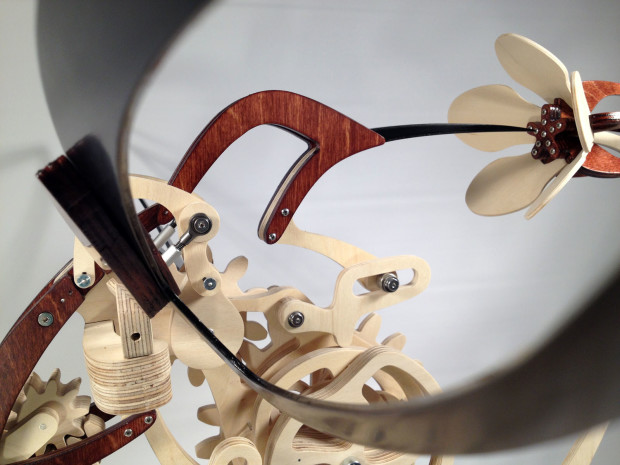
Derek Hugger designs his automata the hard way. He uses Illustrator for the initial basic forms, sketching them out on a Wacom tablet, and then uses animation software to see them in motion.
“More than really overthinking it, I just started drawing stuff,” he says. “I just kind of kept going at it until I got something that worked.”
Hugger’s day job is as a mechanical designer for a company that builds medical equipment, a job he loves partially because it gives him access to learning resources and the machine shop there. He started building automata because he wanted to replicate a skeleton clock for his bedroom. He couldn’t find plans online, so he designed his own, cutting it out with a bandsaw and scroll saw. Then he wanted to build another, for his dad, but Father’s Day was just three weeks away. So he bought a CNC router. After he was done, he started creating other types of automata, and realized he could sell the plans. (They range from $19 to $99 on his website.)
For his hummingbird, which is called Colibri, he brainstormed with a coworker about how to build something more unusual, something inspired by nature rather than just mechanical. Hugger thought a flying hummingbird would be interesting. “I remember him looking at me and going, how the hell are you going to do that?” he says. “And I said, I have no idea.”
[youtube:https://youtu.be/1scj5sotD-E]He went online and watched slow-motion videos of hummingbirds. Then he put one video into animation software and animated a plane right over it, to get the articulations just right. “They’re not just best guesses and artistic interpretations, a lot of the motions in the sculpture are based on real video of hummingbirds,” he says.
It’s a complicated design because of the independent movements of the head, wings, and tail, as well as the back-and-forth motion that brings it to the flower. It’s based on hypocycloid gears, which slow the motions of the different parts to the appropriate rates.
The most challenging part, says Hugger, was the wings. Unable to find examples of an appropriate mechanism online, he gave up and designed it himself. He started at the end, with the motion the wings needed to make, and worked backward. He added the linkages and pivots he knew he’d need, and watched the shapes their motion traced — roughly a kidney bean shape. Remembering that a four-bar linkage could drive that, he built one and attached it to the drivetrain, carefully adjusting its dimensions so its motion would match that traced by the wing as closely as possible.
Then he finished it, sanding at 400 grit and staining the parts by hand. And then it blew up on YouTube. “I was hoping it would be well received, but I was not expecting the YouTube video to get 40,000 views in a week,” he says.
Hugger shared some progress pics and sketches (all images courtesy of Derek Hugger):
ADVERTISEMENT












